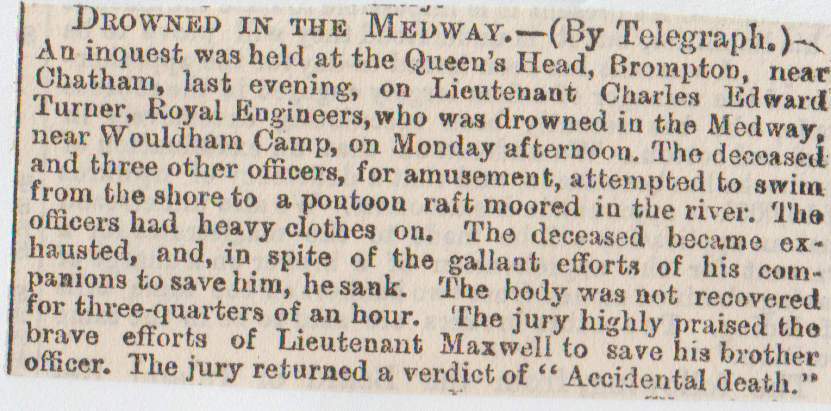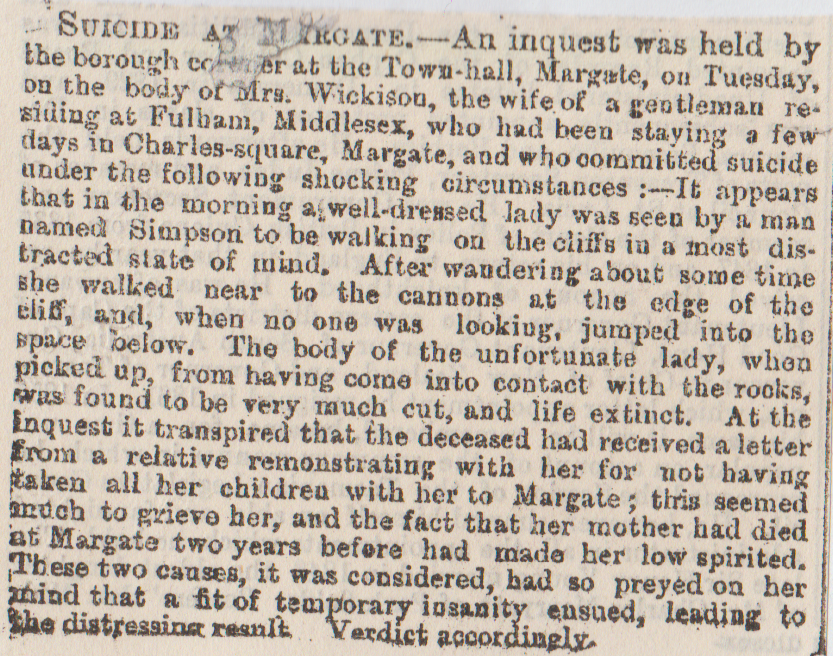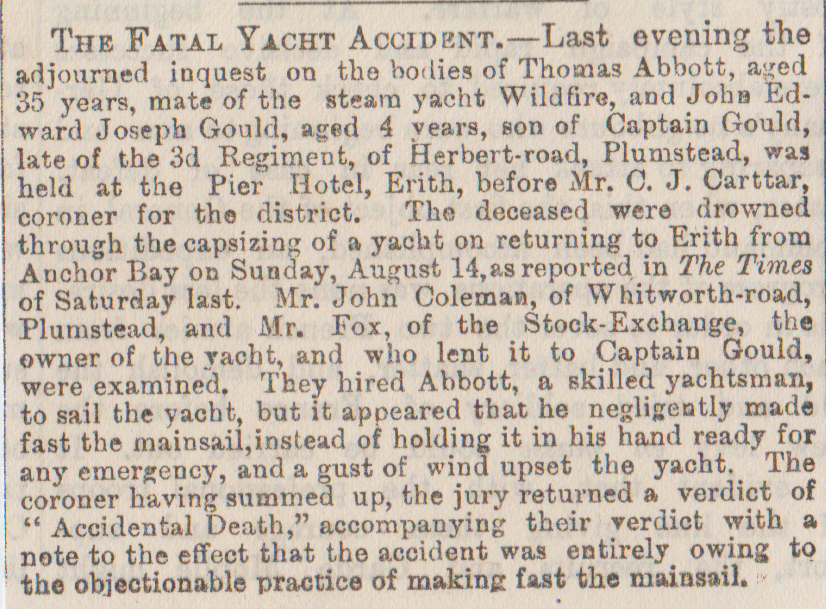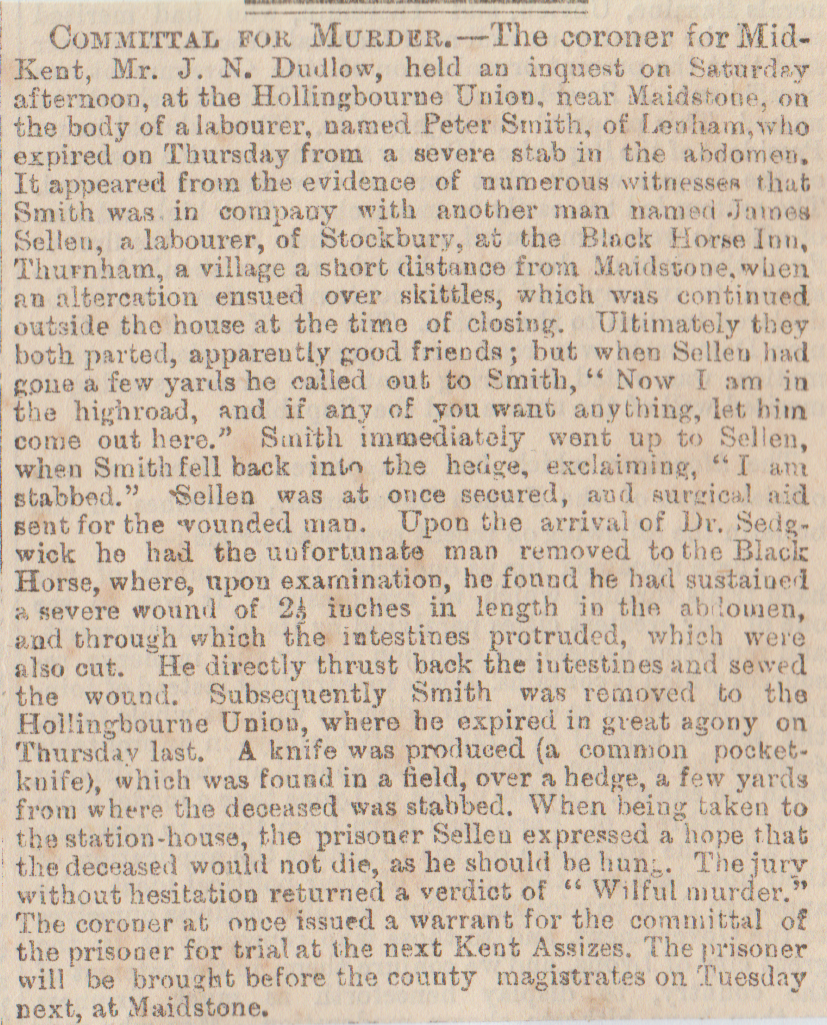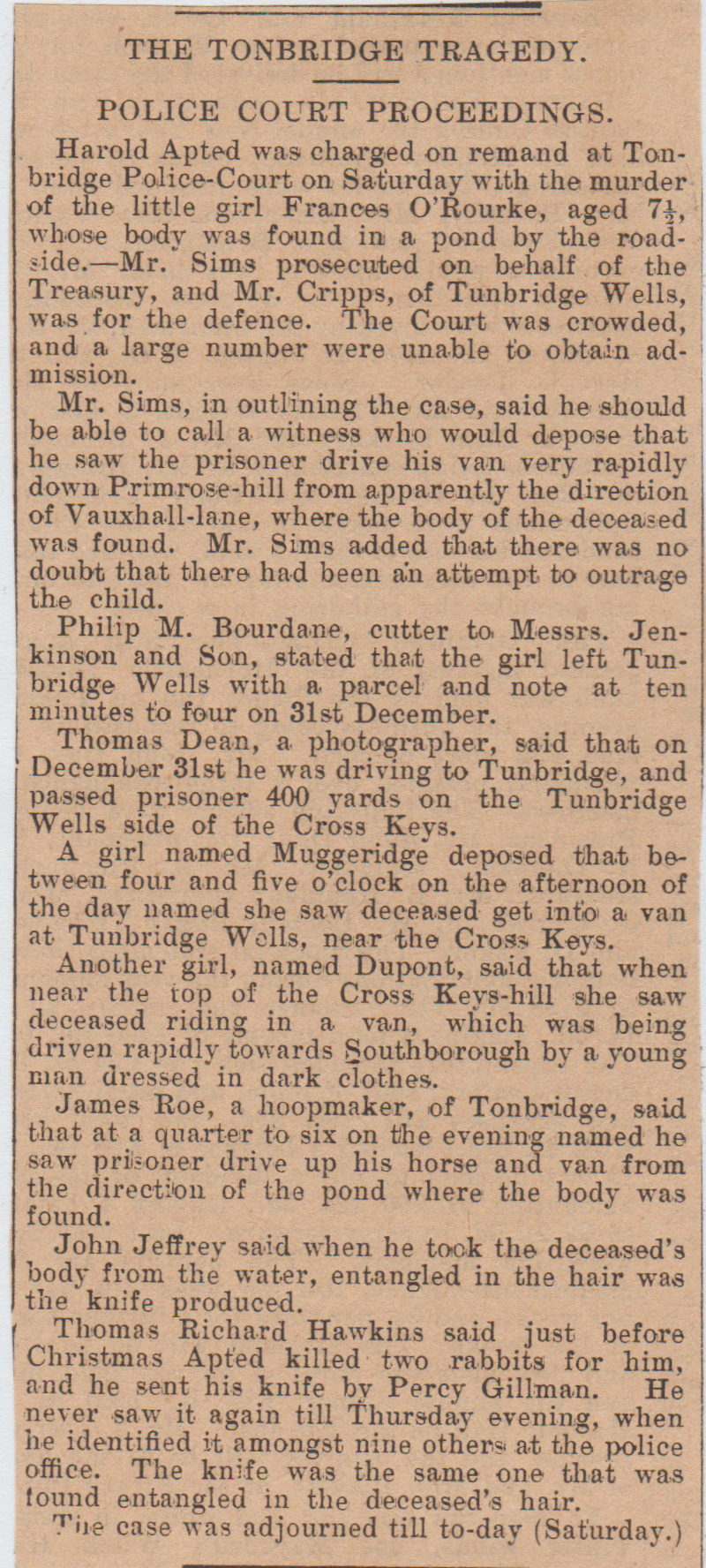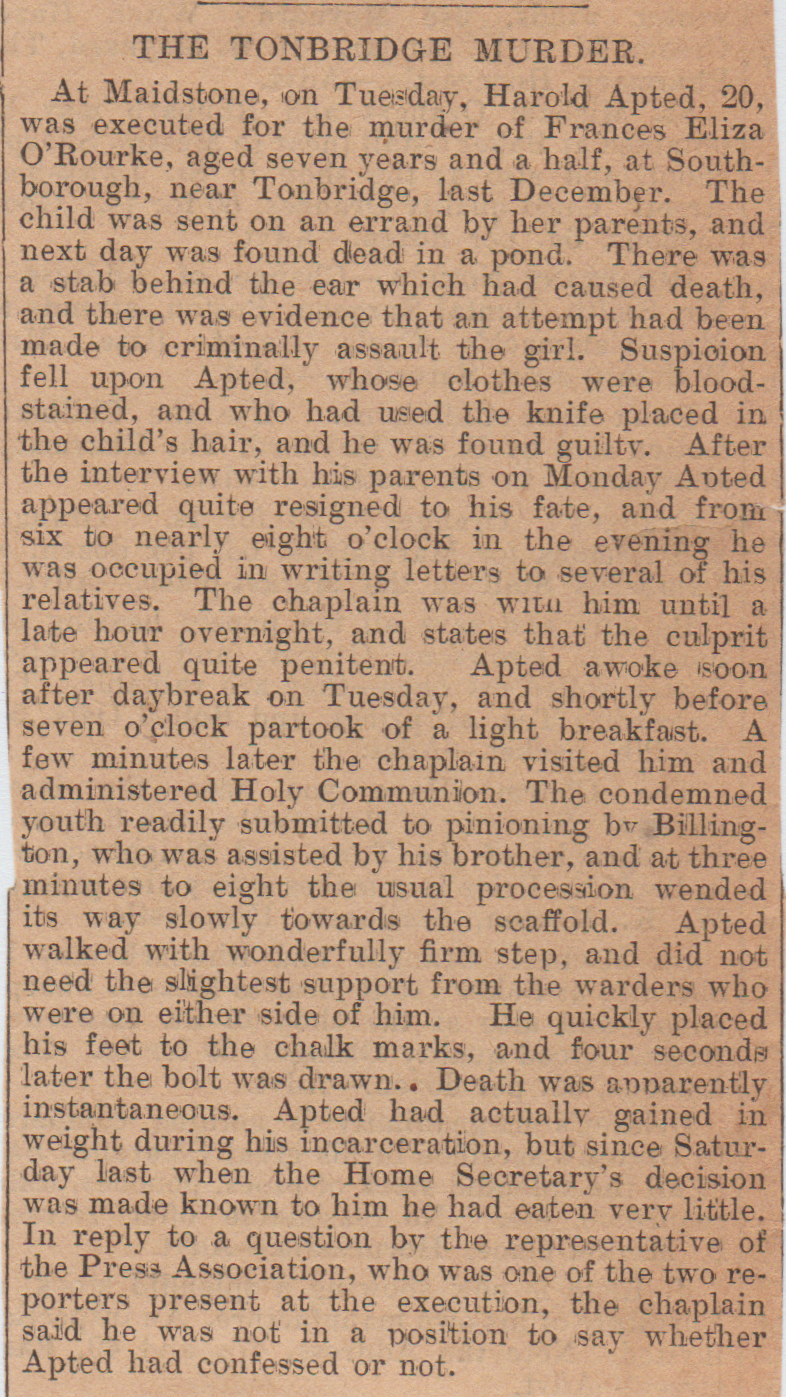1/ Rochester Bridge Suicide, August 1893
William Chanon, a dockyard shipwright from Sheerness, was walking over the bridge at midnight with a work colleague by the name of Kirkwood when he climbed onto the edge and said “I’m off; won’t you join me? ” and jumped into the Medway.
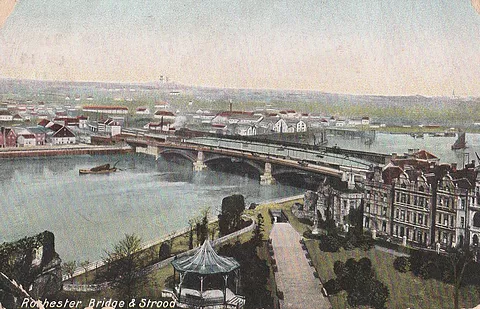
2/ Rochester Bridge Suicide, December 1904
Wife of the chairman of Aveling & Porter, Mrs Thomas Aveling, was prone to bouts of depression. She managed to evade her nurses one day and got into a cab, then headed for her husband’s office next to the bridge. When she was travelling over the bridge she calmly got out of the cab and leapt to her watery grave. (Body found?)
3/ The Warren, Folkestone, April 1910 (Child Killed)
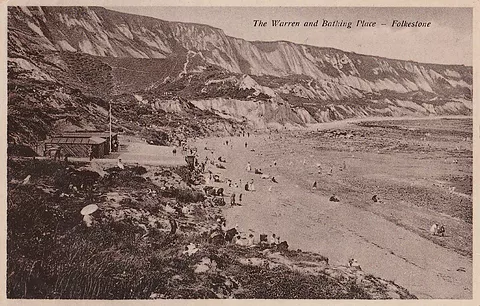
The picture postcard (my own collection, as are all the postcards) is of the Warren which is where three young schoolboys went climbing, when one of the group, Georges Nicolas of 8, Rue Du Pont Neuf in Paris, nearly reached the summit when he screamed “I cannot go any further” and fell down, hitting the sides as he went down. They went to his aid and one went to get help, and he was taken to hospital but finally died several days later. The child’s mother came from France to be at her son’s side, but just as she arrived he had passed away only half an hour earlier.
4/ Rosherville Gardens, Gravesend, August 1898 (Body Washed Up)

A police-constable doing his rounds near Rosherville Gardens, found a man’s body lying on the rocks, which had been washed up by the tide. He was smartly dressed, had a £5 note in his pocket and a racing card in his top pocket. Part of his hand had been gnawed away by rats. It was estimated that his age was about mid-thirties, but no further clue to his identity was forthcoming.
5/ Shakespeare Cliff Suicide, Dover, August 1873
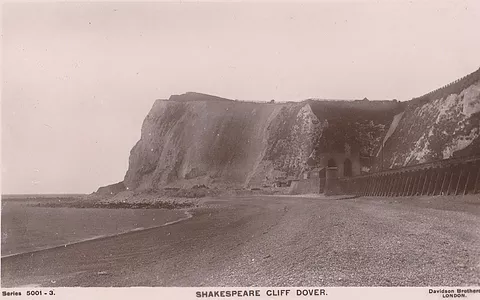
A smart looking gentleman, apparently by the name of Merrin, who lived at 56, St Stephen’s Road, Bow, in London, decided on committing suicide by rolling down Shakespeare Cliff at Dover. This is approximately three-hundred feet high.
6/ St Mary’s Cemetery Suicide, Dover, May 1890
A labourer was found with his throat cut in St Mary’s Cemetery, in Dover. He had been unemployed for some time. As yet there was no identification of the man. (Who was he?)
7/ Bexley Fatality, December 1900 (I know Bexley is now part of London, but it wasn’t then.)
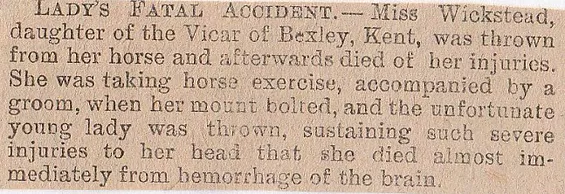
8/ Tunbridge Wells Vicar Suicide, September 1906

9/ Sheerness Fatal Shooting, December 1872
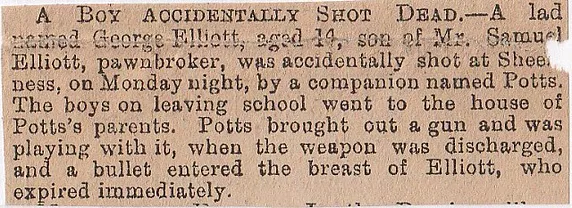
10/ Strood Murder, January 1885 (I know it says Stroud, but Strood is near Maidstone!)
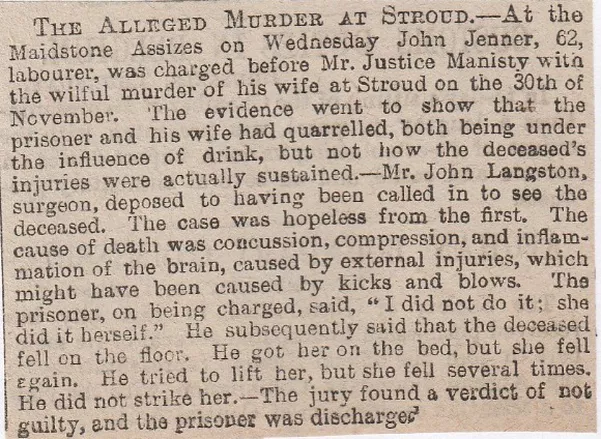
11/ SladeGreen/Dartford Station Deaths, October 1909
A fireman was walking along the South Eastern Railway between Slade Green and Dartford Stations at about 2-30 in the morning, when he came across the dead bodies of a male and female, both mangled by the train, with the man having been decapitated, but his right arm was clutching her around her waist. The fireman went to get help and the corpses were brought to Erith. The couple were identified as Walter Henry Hollands, a twenty-one-year-old carter and his girlfriend Ellen Matilda Day, twenty-two-years-old. (Was is an accident or suicide pact?)
12/ Style Bridge Murder? July 1893
The body of an old man was found in a field at Style Bridge in Kent. The face was bruised and battered and it looks like a case of murder. Police are treating it as foul play. (Could it be Stile Bridge?)
13/ Royal Oak Hotel Suicide, Ramsgate, February 1886
Sydney Montague Albert Wood, a defaulting stockbroker who worked with Tokenhouse Yard Bank, who lived in Streatham, killed himself at the Royal Oak Hotel in Ramsgate. It is claimed that just one of his clients owed £80,000 and a warrant was issued for his arrest. His brother, Horatio, received a telegram from him, saying-“Cannot come up; better come down. Be very firm”, this was a reply to his proposed meeting with his brother in Herne Hill. Horatio and another brother Charles went to Ramsgate and tried his room door but it was locked, they forced entry and they found their brother in bed, fully clothed and quite dead from prussic acid poisoning. A letter on the table read: “I would rather suffer death. When you arrive you will find I have gone to render my account to the great Judge. My brain is on fire: I hardly know what I am doing.”
I think the Royal Oak Hotel is still there, correct me if I’m wrong. (What room was suicide?)
14/ Tower Hill Skull Discovery, Upnor near Chatham, January 1894
A group of excavators working for Messrs Scott, Government contractors, were digging some earth to make a sort of embankment for a military railway when they came across twenty or so, skulls. They were all human and had excellent teeth and in remarkably good condition. (Where are they?)
15/ Sevenoaks Fatal Cycling Accident, February 1898

16/ Sheerness Murder, April 1901
The body of Mrs Sarah Lancaster, the wife of naval pensioner George Lancaster, was found at the residence in North Street Passage in Sheerness, only a few yards from the side entrance to Mile Town Railway Station. George Lancaster is seventy-one-years-old and she was fifty-five-years-old and he has been arrested. They had lived separately for several years and she had lived with her sister in Unity Street, but her husband had been paying maintainance. When police were alerted by a member of the public to go to North Street Passage, they entered and they found Sarah lying under a table with terrible wounds. George Lancaster was stood behind the door with a hatchet in his hand, which he’d just washed the blood off. He had been drinking and attacked her as she came in through the door and police took him to Sheerness Police Station.
17/ Broadstairs, March 1901 (Cliff Suicide)
James Smoothey was a builder from Ramsgate, whom it seemed that he was in dire straits financially, but he had miscalculated and he was all right. He’d got it in his mind to commit suicide and went to the cliff between Broadstairs and Stonestairs. At about two p.m. one afternoon he was found at the base of the cliff, face down with his mouth buried in the sand, a broken leg and several contusions. The cliff is about sixty feet high and although suicide was the most likely cause, the jury gave the following verdict- ” That deceased, James Smoothey, who had for some time been in a desponding state of mind, was found dead at the base of the cliff near Broadstairs; and that he died from injuries received from the fall, but there is no evidence to show how he came there”
18/ Beckenham Fatal Explosion, February 1885
A shocking accident occurred at a brick works at Beckenham, in Kent, through the explosion of a boiler, which caused the fall of a tall stack. Several men are reported to be killed, of whom four leave wives and families. The bodies have been extricated.
19/ Tonbridge Carriage Accident, May 1899
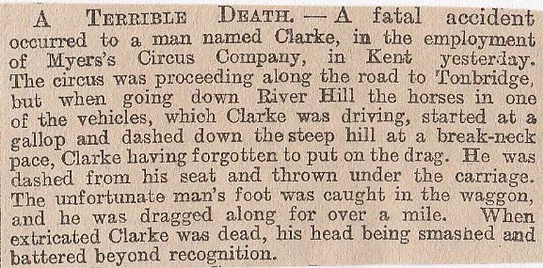
20/ Sandwich Double Death, July 1897
First one was that of a young girl found drowned in the river Stour near Sandwich. There is no clue as to how she came to be in the water. The other was a boy named Knight, who was knocked down by a train and cut to shreds whilst he was walking over Woodnesborough level crossing near Sandwich.
21/ Dover Skeleton Discovered, April 1882
A skeleton has been found, supposedly that of a man named Spence who was one of the last victims of public execution. Workmen were digging in the High Street at a crossroads formerly used for public executions, when they found the perfectly preserved skeleton of a man. The man Spence was convicted in 1822 of smuggling, although a man of means he became embroiled in the smuggling game. A government officer captured him but not before he’d shot at him. The execution took place at the crossroads. When he was dug up by workmen, the remnants of Spence were taken to the Gas Works at Dover. It seems unlikely they will be given a Christian burial and were refused admission to the Cemetery. (Where were they buried?)
22/ Folkestone, (Murder/Suicide?) March 1885

23/ Littlebourne near Canterbury, March 1859 (Vicar’s Suicide)
The parish of Littlebourne near Canterbury has seen the suicide of the vicar, Reverend J.Woodcock, who decided to shoot himself. Not many in the village liked the chap and his congregation consisted of a handful of people. The recent scandal of a housemaid having left pregnant was due to be investigated and this could have been the straw that broke the camel’s back. The strange thing is that he shot himself in the temple, while in full view of his wife in their bedroom. Jurys verdict was that he was in a state of mental derangement, which is probably the right decision.
24/ Usingal near Margate, November 1841 (Double Death)
A woman was passing through Usingal, when she heard cries for help coming from a pond near the roadside. She hastened to the spot and saw a man flapping his arms, barely keeping his head above the water. She went and got help but when they got there, only a hat was found floating on the surface. The pond was dragged and a horse and gig were taken out with the horse dead and a couple also were found. Mr and Mrs Brown had been married a couple of months and it is believed that he took the horse for a drink at the pond and slipped in. Mrs Brown was also known as one of England’s finest violin players.
25/ Lydd Camp Fatal Explosion, June 1895

26/ Sittingbourne, (Childs Body Found) January 1877
The father of a fifteen-month-old child named Dean, who lived with his wife and three kids in poverty in just one room, was questioned about the death the child. The little one had died a number of weeks ago and the parents, instead of burying it, put the body in a cupboard where it began to decompose and give off a terrible stench. The family carried on eating and sleeping in the same room and eventually when the child was discovered it was in a sack under the bed. The father’s excuse was that could not afford a burial.
27/ Chatham Suicides, July 1892
A couple of suicides have rocked the neighbourhood of Chatham. The first was a dairyman, Edward Cornwell, who was found at his premises at New Brompton with his throat cut. He was depressed of late. The second was George Woollett a naval pensioner aged sixty-five,who went to a chalk pit in Upnor and cut his throat with a clasp-knife. He lay undiscovered for several hours.
28/ Strood Station Fatality, February 1899
Alfred Streadwick, a twenty-seven-year-old railway porter, was struck down by a train at Strood Station on Sunday night and was killed instantaneously.
29/ Dover, (Collision Kills Three) April 1885

30/ Canterbury Suicide, April 1879
A young lad who had gone missing for five days, was found by an attendant at the swimming baths on the road to Whitehall. He saw a hat floating on the surface, went into the water to fish it out and then found the body of the 17-year-old youth named Williams. He had some argument with his parents about his proposed marriage and due to this, he had committed suicide. A letter was in a pocket containing a lock of hair and with his Mum’s address on it. It stated his love for her and the rest of the family, but also to “his dear Anny.”
31/ Deal, Skeleton Found, February 1898
While workmen were digging the foundations for a new building behind the new South-Eastern Hotel at Deal, an entire human skeleton was unearthed. No sign of a coffin was present, but remnants of a woollen scarf were round the neck. It is male and is about six feet tall and it is in the foundations of the old Naval Dockyard.
32/ Fort Clarence, Rochester, (Human Skeleton) January 1893
Down by the Medway at Fort Clarence, Rochester, some Royal Engineers were excavating. They came across a female skeleton and when police were fetched to investigate, they said it could be a murder victim from years ago, and the murderer had disposed of the body in this lonely spot. (Was it Murder?)
33/ Faversham Fatal Stabbing, August 1889
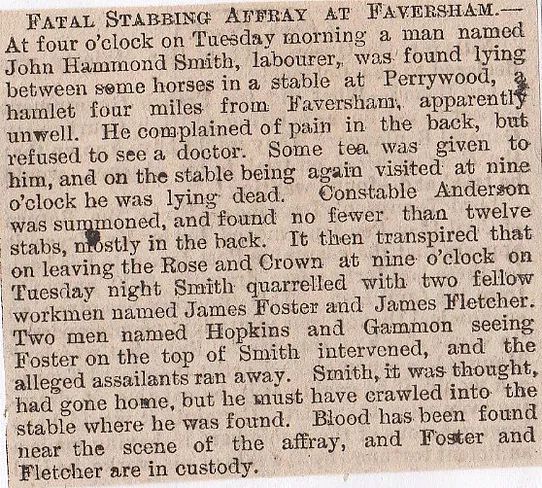
34/ Belmont Hill, May 1843
Sarah Wright, a ninety-two-year-old woman decided to cut her life short by committing suicide at Belmont Hill, Lee, in Kent.
35/ Folkestone, September 1893 (Two Women Found Dead)
The bodies of two middle-aged women were found on the beach at Folkestone by fishermen one morning. The women are visitors to Folkestone and police are investigating the matter. The younger of the two had a bruise on the left eye but could have been caused after death while in the water. There is no boat missing, so they’re clearly not victims of being washed overboard from a ferry or similar. Later on, one of them was identified as that of a woman named Treadwell who was in service in Hythe until recently and has since lodged at Folkestone. Her father killed himself a couple of years ago and since then she hasn’t quite been in her right mind. The identity of the other remains a mystery, but on Saturday evening a harbour employee heard screams. The evidence points to drowning. Neither had any money, but one had a handkerchief with “A.G.Brown” sewn into it. (Who was the other?)
36/ Sun Pier Suicide, Chatham, July 1872 (Suicide)
Miss Anna Woodthorpe, who lived at New Brompton near Chatham, leapt into the Medway from Sun Pier. Before the well-to-do lady plunged into the water, she tied a heavy weight to her body just to make sure of drowning. The water was dragged a couple of hours after her leap of death and her body recovered.
37/ Chatham Pier Collapse, July 1885
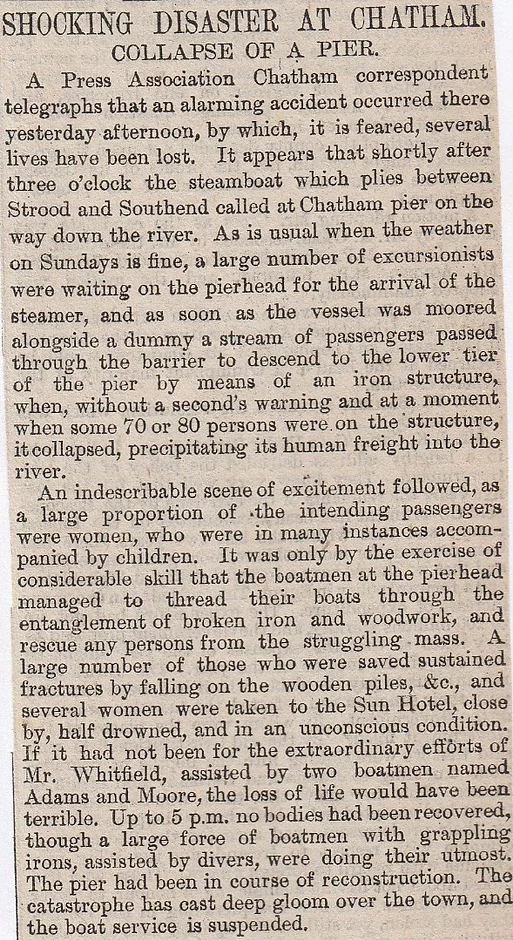
38/ Milton Church, Gravesend, October 1884 (Suicide)
The body of twenty-six year old Alice Hughes was found on the North Kent Railway near Milton Church, around three hundred yards from her house. The body was found decapitated. Alice had been a barmaid at Broad Street Station and left on the account of her eccentricity. She was seen alive at her home in Prospect Grove on Saturday evening and although in a sombre mood, she was left alone. Suicide while suffering temporary insanity was the verdict.
39/ Chettenden Prison near Rochester, November 1878
A convict by the name of James Mills killed himself at Chettenden Prison near Rochester. He broke a shelf in his cell in half, leaving a rivet-free. He took off his waistcoat, put his head through the arm-hole and then tied the other end to the rivet sticking out of the wall and hung himself. He was only a few inches from the ground. He was inside for seven years and would have been out by now, but for his escape from prison, then his recapture.
40/ Lydden Spout Suicide, July 1898
Midway between Dover and Folkestone are the cliffs at Lydden Spout. A coastguard was walking along the cliff-top, when he discovered a man’s suit with blood everywhere. A search was made for the owner and he was found at the bottom of the cliff, stark naked, with a frightful gash across his throat. The body was in an awful state and was taken back up the cliff. He is of average height and in the suit pocket was a London Trades Union card with John Smith as the named person. Also there was an Underground railway ticket .The fall of the body was approximately four-hundred-feet, with the face was barely recognisable.
41/ Folkestone Shooting, August 28th 1885
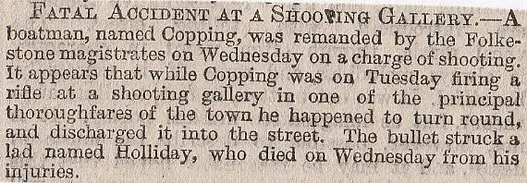
Folkestone Shooting, August 31st, 1885
The man Charles Copping, who accidentally shot a lad named Halladay at a shooting gallery at Folkestone, was on Saturday charged with feloniously killing the lad and was committed for trial at the Maidstone Assizes.
42/ Eastwell Park near Ashford, December 1885 (Stableman Fatality)
A stableman in the employ of the Duke of Edinburgh at Eastwell Park, has been trampled to death by a horse. The man in attempting to mount the animal fell and the horse kicked and trampled upon him, inflicting injuries from which the poor fellow died within a few hours.
43/ Maidstone, December 1885
Major W.H.Murphy, of the 2nd Battalion Queen’s Own Royal West Kent Regiment, was thrown from his horse whilst hunting with the West Kent Hounds on Saturday afternoon near Maidstone and sustained injuries which caused his death.
44/ Newington, Kent, July 1885
At Newington in Kent yesterday, a man named Else was found lying dead in a field under suspicious circumstances. The police are investigating the affair. (Was it Murder?)
45/ Rochester Carriage Accident, August 1885
A serious accident occurred at Rochester. While a pleasure party were driving through the town, their horse took fright and the carriage was overturned. Of the six occupants, five were badly injured. One lady, Mrs Pritchard, died soon after her removal to the Mid Kent Hotel and another, Mrs Cox, lies in a precarious condition.
46/ Maidstone/Medway, (Schoolboys Suicide) June 1895
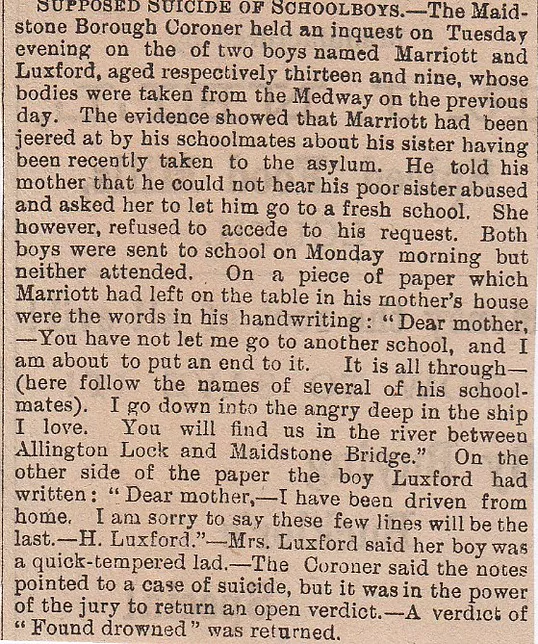
47/ Gillingham Servant Suicide, March 1910
Ruth Louisa Coultham an 18-year-old servant, killed herself by putting her head in the gas oven and gassing herself. The suicide letter stated that she wasn’t mad, but she added: “My life is a strange one, and I have gone through more sorrow than most girls of my age. May God spare my step-mother, so that her children may not know what it is to be motherless, as I and my dear brother did. I hope father will not let this trouble him. I have never been understood by him or anyone else. There is only one who knows the working of our hearts, and He will take me home, and all will be explained. In my life I have been unfortunate, it seems, but all will come right in the end- of that I have no fear.”
It was stated that she was prone to sudden fits of depression.
48/ Borstal Skeleton, near Rochester, July 1879
A group of prisoners were excavating for the new fort, which is going to to be built at Borstal near Rochester, for the defence of Chatham Dockyard and Garrison, they discovered the skeleton of a male. It seems from the post-mortem examination, that he met with foul play some years ago and was thrown into the hole dug in a wood. (Where is it?)
49/ Sandling Junction near Folkestone, June 1899 (Traction Engine Fatality)

50/ Southborough, March 1902 (Grave of Murder Victim Vandalized)
The little girl who was murdered in Tonbridge, Frances O’Rourke, and was buried at Southborough, has had her last resting place vandalized.The murderer Harold Apted is currently under the sentence of death. The tombstone which had been placed at the grave by the child’s friend’s was torn down and was the artificial wreath also put there. This is thought to be some sicko, who apart from this dreadful act also sent the girl’s parents some threatening letters. Police are working on the case, but have no leads as yet, to the miscreant’s identity.
51/ Broadstairs Cliff Fall, July 1855
A young lady by the name of Sophia Weatherby had been staying with her sister in Broadstairs. She went out for a walk by the cliffs, between the bridge and Dumpton-stairs. A passer-by warned her not to walk too close to the edge, she thanked him for the advice and carried on. The man turned around to check and she had vanished, so he gave the alarm. The people below saw her drop onto the ground, while they promenaded along the pier. They discovered her body at the base and surmised she had fallen about eighty-feet and had head injuries and a broken thigh and both ankles were shattered as well.
52/ Dover, December 1885 (Sufferings at Sea)
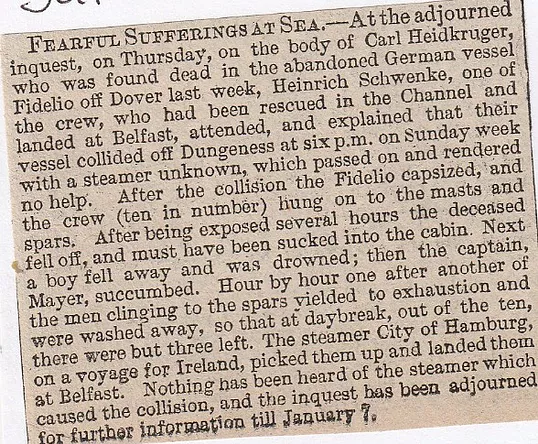
53/ Gravesend Cemetery Suicide, May 1890
Joseph Davis was found dead in Gravesend Cemetery, with a bullet wound to the head. A note found on the body read:-
“No use seeking for my friends. I am alone in the world and have gone mad by losses and other circumstances. I am crazed. No one to care for me. No one to care for me. Weary, mad, mad! Poor me-J.Davis, Gravesend”.
The deceased had been a sub railway contractor, but recently had nothing to do. The verdict of “suicide whilst temporarily insane “was reached.
54/ Margate, September 1888 (Human Remains)
Some human remains have been found at Margate while digging in a field next to Trinity Church. The chap was digging away when his pick-axe hit a cavity and an underground chamber suddenly appeared beneath. It was about twelve feet in height and inside were numerous bones and other remains. Also, there was a huge passageway, probably connecting the chamber with the seashore. About a hundred yards away were some smuggler’s caves and this is thought to be part of this former operation, but what the bones are there for, or who they are is a mystery.
55/ Maidstone Execution, January 1890

56/ Greenhithe, (Children’s Bodies) January 1888
The coroner for West Kent was informed of the discovery of the bodies of three children, which were embedded on a railway embankment at Greenhithe. They were in a carpet-bag and were extremely decomposed. The theory is, that they were thrown out of a passing train.
57/ Hythe, (Accidental Choking to Death) March 1918
A hero of Mons, Captain S.C.Tinne, R.F.C., was found strangled in his room at the Imperial Hotel in Hythe. Captain Tinne won a Military Cross as well as his heroics at Mons, so his actual demise is an unfitting end for such a man. The theory is that being fond of musicals, his favourite character was that of a parson and while packing ready to leave, he found a wig and put it on, then seen an elastic band which he used as a bandage for his injured knee. It is supposed that he put it around his throat to see what hanging was like (I know it’s pretty thin up to now!), and accidentally choked himself. The verdict of the jury was “Accidentally Suffocated”. It doesn’t sound very plausible to me, more likely some auto-asphyxiation game gone wrong while wearing a wig. (Is Imperial still there?)
58/ Cliff near Rochester, March 1885 (Burned to death in Kiln)
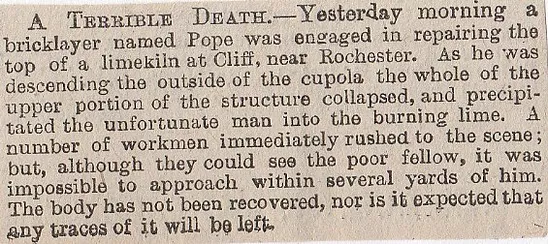
59/ Sandgate near Folkestone, March 1890 (Body in Jar)
Several parcels were received at the station at Sandgate, from Regent Street parcel office in London, consigned to an office at Shorncliffe Camp, one had no address on it and there was no reference to it in the way-bill and it was conjectured that it had been put there after the way-bill had been done. When opened, it was found to contain a stone jar with a body of male infant preserved in liquor. The body had the top of its skull missing and a hole in its chest, therefore foul play is assumed the cause of death.
60/ Chatham, (Bayonet Fatality)May 1860
A singular accident occurred at Chatham to a Royal Marines private, named James Pattison. He was with a group of other soldiers who were being instructed in the use of rifles on Chatham Lines and were being drilled in judging distance, when they were told to fall-out for a break. Pattison decided to do some somersaults to impress his mates and was performing one when his bayonet fell out of the scabbard and fell on the floor pointing upwards, then he fell on it. He died within the hour.
61/ Uplees, Faversham, May 1899
An explosion occurred yesterday morning at the works of the Cotton Powder Company at Uplees, Faversham, and sadly James Thomas Bean aged thirty-three lost his life.
62/ Sheerness, March 1885 (Two Drowned)

63/ Dover, (Salute Goes Wrong) January 1858
The landing of the Princess of Prussia at Dover met with an atrocious accident as well. The usual salute was fired on its arrival and on board the Black Eagle, there were found two gunners of the Royal Artillery, Michael Martin and John French. While firing the guns an explosion blew their hands and arms off. They were taken to Dover Hospital and both men had to have both arms amputated, and they are both in a precarious condition. (Did they live?)
64/ Maidstone, April 1832 (Rake Death)
A freak accident caused the death of a small child, the daughter of Mr Wedd. The servant was carrying the child in the garden, leading a little girl, who took hold of a rake that had been hung to a tree when the rake fell. One of the teeth entered her skull and caused its death.
65/ West Cliff Terrace, Ramsgate, January 1893 (Human Remains In Cellar)
During some alteration work being carried out on West Cliff Terrace, some human remains were discovered under the floor of the cellar, which was the only one in the row of houses to have a cemented floor. This is the reason why! The part corpse was the lower region of a lady’s body and police are investigating the situation, plus further excavations to find the rest of her body.
66/ Rochester Bridge Station Fatality, July 1900
A dreadful accident took place on the London, Chatham and Dover Railway, near to Rochester Bridge Station. William Usher was driving a horse and cart over the level-crossing when he collided with an express train which he had not spotted nearing the station. The horse and cart were smashed to atoms and the driver was instantly killed.
67/ Dover Manslaughter, February 6th, 1899
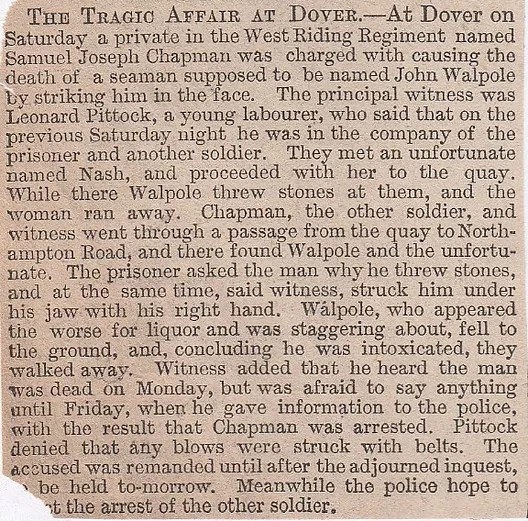
68/ Dover Manslaughter, February 8th, 1899
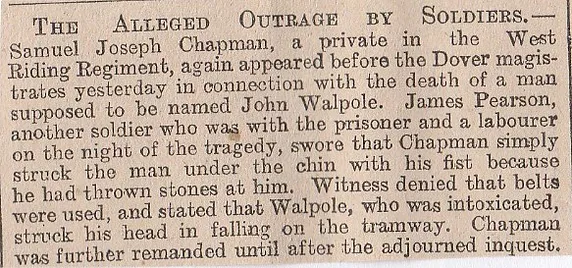
Dover, February 11th, 1899
At Dover yesterday Private Samuel J.Chapman, 1st West Riding Regiment, was committed for trial on a charge of having killed a seaman named Walpole by knocking him down. The magistrates offered to accept bail in two sums of £25 and the prisoner himself in £50.
69/ Cobham Hall Suicide, near Gravesend, April 1881
Cobham Hall is the seat of the Earl of Darnley, was the scene of a strange suicide. A waggoner named Stephens was found hanging in a loft. The man who discovered the body refrained from cutting him down, instead, he ran to get the head gamekeeper who then sent for the police. When cut down he was quite dead.
70/ New Road, Chatham, October 1898 (Haunted House Vandalized)
A crowd of young men went on a rampage to wreck a house in New Road that was supposedly haunted. Windows were smashed and doors covered in mud, but the damage could have been worse were it not for the presence of police. The house was furnished but untenanted.
71/ White Hart Hotel Suicide, Margate, August 1885
A suicide was committed in the White Hart Hotel in Margate, with the victim being one Arthur Daniel Terrent of 28, Clarges Street in London. Terrent was a former stockbroker and was staying in Margate for a while, and had even invited friends for dinner that evening, but was in a sombre mood. He soon left them and went to his bedroom, then pulled out a revolver and placed it to his temple and fired. He died within five minutes. (White Hart still there?)
72/ Marlborough Head Pub, Frindsbury, (Fatal Fire) March 1899
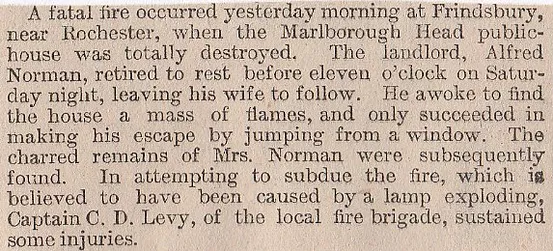
73/ Northfleet Suicide, August 1831
A young lad committed suicide in Northfleet due to his gambling addiction. The boy worked for Mr Law of Northfleet and had always been a good worker who listened and obeyed his master. His vice was that he used to get together with a party of lads the same age as him (16),and have a bit of a gamble. He went to see them one afternoon and during the games, he lost seventeen shillings. His back luck and his losses preyed upon his mind, so he hung himself by a neckerchief in his masters stable. The verdict was one I haven’t heard before-“Deranged and Distracted.”
74/ Faversham, March 1893 (Body Hanging for Two Months)
A man named Exton from Boughton near Faversham, left home a couple of months ago to look for work. On Sunday afternoon some kids were playing around a barn in a neighbouring village to Boughton, when they found a man’s body hanging from a beam. They ran out and got assistance and on further investigation, it was found to be Exton, who had been there at least two months, due to decomposition.
75/ Sittingbourne Railway Station, August 1885 (Fatal Accident)
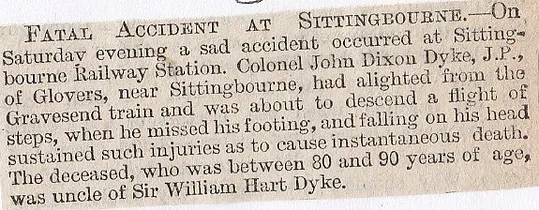
76/ Riverhead, Sevenoaks, September 1896 (Devoured By Rats)
An awful discovery has taken place in Riverhead near Sevenoaks. It was at the allotment gardens and due to an exodus of rats from a rubbish tip to a plot of garden, led to a search being made. The result of the search found the remains of an old woman who had been there about four weeks. The whole of the face had been eaten away, with the exception of the nose and teeth. Death was due to starvation and she is said to be a visitor to the area and sought work as a hop-picker, but could not find any.
77/ Folkestone Bodysnatching, October 1888
A vault in the local churchyard was smashed open and four coffins and their contents were stolen. The vault was that of Francis Macnamara Faulkner, a well-known shipping agent. In there were the bodies of Mr Faulkner, his two wives and a daughter, the first interment being in 1853. The churchyard is at the centre of Folkestone and hundred’s of folks pass it daily. (Were They Found?)
78/ Tenterden Pram Fatality, September 1885
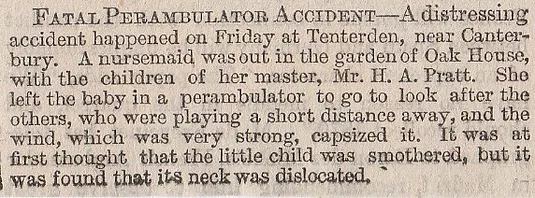
79/ Dover Cliff Suicide, November 1899
Dover police are investigating a rather mysterious affair, the discovery of a woman’s body at the base of a cliff. They first were alerted to something wrong when a lady’s green cloth jacket and a straw hat were found on the cliff top, near the convict prison. The further search revealed the body aged about thirty-five, several hundred feet below on the foreshore. The body though, has no injuries consistent with her death. She is unknown and has pale skin and brown hair.
80/ Royal Bull Hotel (Body Discovered), Dartford, March 1899
A human skeleton was discovered under the Royal Bull Hotel in Dartford, which dates back to the days of Wat Tyler (1380’s). The remains are over a hundred years old and are thought to be those of a murder victim in 1773 at the old inn. Workmen were excavating, when about six feet down the skeleton was unearthed. The body was examined by the police surgeon and he stated it had three bullet holes in it, and after passing through the body they lodged in a wall of the upstairs room in which the murder happened. A weird postscript to this story was that the body disappeared after the surgeon examined it, never to be seen again.
81/ Upnor Drowning, Chatham, October 1897

82/ Herne Hill Station Suicide, April 1878
A smartly dressed gentleman went to the stableman at the Half Moon pub and asked if anyone wanted to earn ten shillings. The stableman thinking he needed a horse and trap asked where he wanted to go, but the chap said he just needed his shoes cleaning. The stableman did it for him and got a half-sovereign and afterwards said that the man appeared to be very excited. While cleaning the shoes the man said that he had just lost £1800 on the Grand National, a phenomenal amount of cash in those days. (It is now!) He said he had not got the money to pay it and around half an hour later was seen near the railway station, where he put his neck on the line and let the train decapitate him. The head and body were taken off the line. In one pocket was a card with the name “Mr Cummins, Solicitor, Canterbury”, along with a gold watch and a large amount of cash as well.
83/ Goddington Villa Suicide, Strood, November 1897
Twenty-year-old servant, Emily Garnett, who worked for Mr Frank Drake of Goddington Villa, Strood near Rochester, was found dead in bed, suspected of poisoning herself with carbolic acid. The bottle was next to her, as was a letter addressed to her Dad saying that she was going to keep her word never to darken his door again. Elsewhere she writes that she did not forget that he had called her his greatest enemy and the Lord knew she would be sorry to be her father’s enemy.
84/ Swanscombe near Dartford, October 1885 (Footy Death)

85/ Sevenoaks Murder/Suicide, March 1897
Harry George Purday shot his wife on Thursday evening, then turned the gun on himself. It was a case of a jealous husband going ballistic and the verdict was “Suicide while of unsound mind”.
86/ St Mary’s Church Suicide, Dover, May 1834
Near the top of the page is the story of the suicide in the cemetery, but this was in St Mary’s Church in Dover. A seventy-year-old widow named Mrs Russell, hung herself from a hat-peg in the vestry in the corner of the gallery on the left of the eastern entrance to the church. She had been lodging in the town for five months and on a Monday morning, she left home but never returned. A search was made and she was found in the church. The wife of the clerk and another lady with Mr Wrightson found her suspended, her bonnet was on with the veil down and a seat nearby suggested that she climbed on that, then jumped off it. It is thought she hid until nearly dark, when organ repairmen and others had left the premises. Part of her strange behaviour was left her valuables at home and cut her own hair as short as possible. “Temporary Insanity” was the verdict.
87/ Chatham Dockyard Drowning, June 1895

88/ Sittingbourne Skulls Found, May 1885
While workmen were digging the foundations of a new cottage being built at Key Street near Sittingbourne, they came across the skulls of eighteen human beings. (Where are they now?)
89/ Sturry near Canterbury, December 1891 (Recluse with Cash)
A reclusive old lady, Sarah Flood, was found dead at her home. She lived alone and was eccentric, to say the least, and when found, she was semi-nude and extremely neglected. When the house was searched, they found cash, jewellery, cheques and so on, worth around £1200. Her bank book also was discovered and she had credit of several hundreds of pounds, so why she was found in such a squalid condition is anyone’s guess.
90/ Rochester, (Sewage Gas Poisoning) June 1899

91/ Charing Motor-Car Explosion, April 1897
The boiler of a motor-car, which was being worked on by William Brakefield the engineer who made it, exploded with a tremendous force. Brakefield was sat in the driver’s seat when it exploded and was hit by the shrapnel and suffered frightful injuries as a result. The skull was fractured exposing the brain and he had no hope of surviving this accident. It was caused by compressed air building up. With no escape, it became a time bomb.
92/ Chatham Soldier Deaths, October 1857
At about nine o’clock on a Sunday evening, two soldiers from the 43rd Light Infantry fell over the cliffs at Chatham Lines. One died on the spot, with the other in such a serious way that survival is barely possible. Joseph Asplin the deceased, had been with his mate in Brompton and were going back to barracks when they heard the drums beat for “tattoo”. They rushed to make it back and being oblivious to the dangers of the cliffs, they cleared a fence and kept running on when they fell over the cliff into the soldier’s burial ground below. They were both taken to the hospital, Asplin was already dead. Verdict-“Accidental Death- killed by falling over the cliffs.”
93/ Shakespeare’s Cliff, Dover, July 1895 (Body Washed Ashore)

94/ Sandwich Quicksand Death, December 1899
A man named James Hyland, who while walking along the dangerous marshes bordering the River Stour at Pegwell Bay, got stuck in the quicksands and was totally engulfed by one of them. The body was washed out of the sand by the rising tide.
95/ Sevenoaks/Dunton Green Murder? April 1869
A farm labourer was walking on the main road between Dunton Green and Sevenoaks when he spotted the dead body of a woman. Some yards from the spot where the corpse was found, the pathway looked as though persons had been struggling together or a scuffle had taken place. In a field nearby were the clothes of the nude woman and on examination, she had sustained facial cuts and bruises. There was no sign of any blood on her or on the ground nearby. The woman was seen a couple of days before, had moved into a lodging house in Dunton Green and had been begging and selling matches in the area. Last seen at half past midnight on Saturday in company with a known criminal, who has since been arrested.
96/ Canterbury Suicide, May 1891

97/ Debtling near Dover, August 1885 (Skeleton)
While digging next to a cottage, workmen found a skeleton about three and a half feet below the surface. The female is five feet four inches in height and is in amazing condition, with no signs of clothing or even wood from a coffin. A small daggers rusty remains were laid near the left arm, with the point upwards. This little clue denotes that a murder was committed there many years ago.
98/ Upchurch Child Death, near Sittingbourne, October 1880 (Peculiar People)
At Upchurch near Sittingbourne, there was the death of a child, which with proper medical help could have been prevented. The child named Sears and they belonged to a small sect known as the “Peculiar People” and died from a bad case of diarrhoea. It had been ill for quite a few days, but no doctor was summoned and was anointed with oil, in accordance with their beliefs. (Is child buried in Upchurch?)
99/ Maidstone Drownings, June 1895

100/ Margate News-boy Suicide, October 1889
A news-boy named Arthur James Pyle committed suicide by placing his head on the rails in front of an express train, on the London, Chatham and Dover Railway. The fourteen-year-old killed himself because of money missing from the newsstand, as he was suspected of dipping his fingers in the till. A verdict of “Unsound Mind.”
101/ Gravesend, (Wives Mass Exodus) June 1829
This one is a funny story of a “mass migration of wives”. In the neighbourhood of Gravesend and Northfleet, at the same hour on the same day, several wives of the most important men in the area just upped and off to who knew where. The husbands inquired of there whereabouts but to no avail. A breakthrough came one day when one husband went to his wife’s mother in Hertfordshire, and she told him rather bluntly that the women had all gone to Ashton-under-Lyne, on a “holy call” to meet Joanna Southcott’s young Shiloh, who according to Southcottian prophets was to come on a certain day. Part of this exodus of women, they had to provide a gift (Not Frankincense or Myrrh), so they took shed loads of their husband’s cash. Sounds a bit like Scientology or Nigerian President’s son, type of scam! One of the women took £500 with her and they all left their own children behind to see Shiloh. (Southcott had been dead fifteen years already)
102/ Maidstone Execution, May 1881
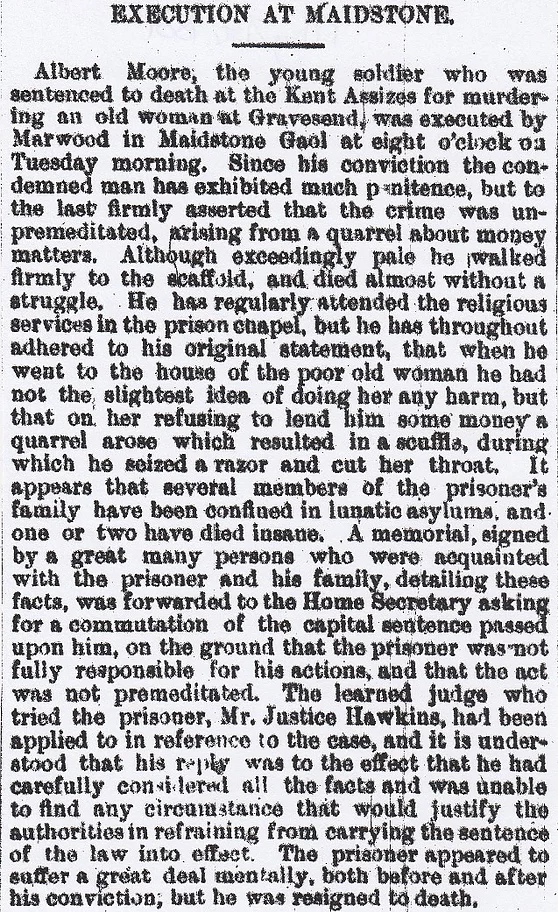
103/ Maidstone Execution, July 1880
Thomas Berry aged thirty-two, was on Tuesday morning executed at Maidstone Gaol for the murder of Caroline Adams at Erith on the 15th of June. The convict was attended by Father Duggan. He repeated in a firm voice the prayer for a pardon from God and man while on the scaffold and he died without a struggle. Marwood was the executioner and only officials and reporters were present. Berry bade farewell to his two children on Monday.
104/ Northfleet Creek near Gravesend, July 1882
Three boys named Patrick Benton, Albert Thomas Duck and Henry Handley, were drowned on Sunday evening in Northfleet Creek near Gravesend, by the capsizing of a rowing boat.
105/ Dover Pit Disaster, March 1897 (Eight Men Drowned)
On the western side of Shakespeare’s Cliff is the Kent Collieries Company works, and it was here that eight men drowned in a shaft. Fourteen men were involved in sinking work, when a great torrent of water flooded in from the bottom. The water was meant to have filtered from the Brady Pit over two hundred feet away.
106/ Kilnodown, (Amazing Suicide Letter Request) March 1899
Michael Colman, a 60-year-old Metropolitan Police pensioner, poisoned himself with laudanum at Kilnodown in Kent. He left an extraordinary letter to the coroner saying that of the £13-16 shillings he had, every juryman should be bought a bottle of whisky and the constable was to receive a sovereign, with whatever was left to be given to the first beggar they saw. They ignored these request and handed the money to his relatives.
107/ Channel Tunnel Plans, July 1866
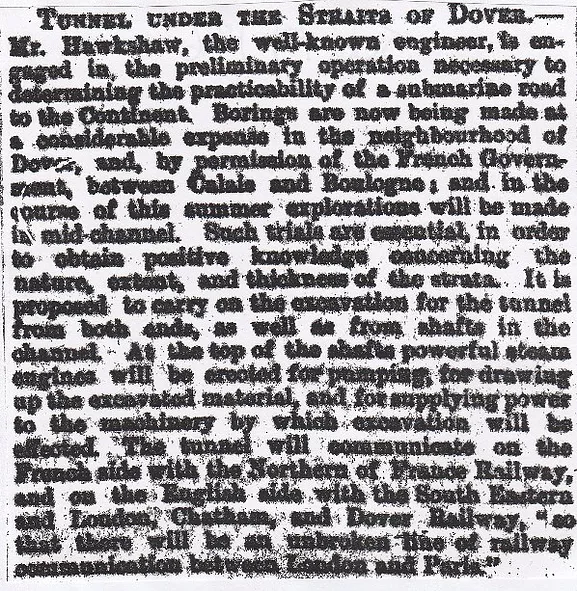
108/ Capel Murder/Suicide, near Tonbridge, November 1894
Stephen Henry Towner aged thirty-six, cut his 29-year-old wife’s throat with a razor and then killed himself. Towner was known to beat his wife, Emily Jane, and many a time she had threatened to leave. She went to a policeman and told him that her husband would not allow her to gather up her clothes, as she was leaving him. The policeman offered to escort her home but she refused and when she went up to the bedroom to collect her stuff, her husband attacked her with the razor. She ran out and got as far as the passageway before dropping down dead. Towner’s mother rushed in and saw her son staring into a mirror, slitting his throat whilst doing so. When doctors arrived and they declared them both dead. Towner had been served with an ejection notice and had terrible money worries too. Now there are four children with no parents-they are aged eight, five, three and one, respectively.
109/ Ramsgate Cliffs Suicide, June 1871
A man on the beach was gathering seaweed, when he came upon the dead body of a well-dressed gentleman at the bottom of the West Cliff, Ramsgate. He’d been dead several hours and he had a gold watch on and some loose change in his pocket. The same man was seen on the East Cliff standing near the edge and was taken to police by a coast-guard because he thought he was going to jump off. He told police his name was Matthew Hornsey aged fifty-eight, of Euston Street in London, and that he was an unemployed accountant who had been drinking and missed the train.
110/ West Cliff Suicide, Ramsgate, August 1871
A woman named Palmer who was the wife of a decorator from Chilton, Isle of Thanet, jumped off the West Cliff at Ramsgate onto the rocks below. A pleasure boat picked up the mangled body and she was found still breathing, though only just. Her suicide attempt was down to jealousy of her husband and the likelihood of survival is nil.
111/ Margate Suicide, June 1895
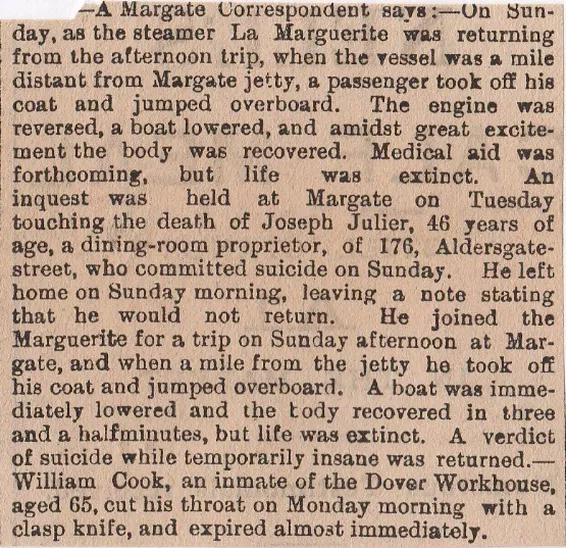
112/ Hythe Skeletons Discovered, November 1875
The Tower near Hythe has been the scene of a discovery of a number of skeletons. The workmen were digging the foundations of a new building at Hythe and were near to Hythe Old Tower, when they found them. The skeletons have been there for a number of years and some still had the last vestiges of flesh on the bones. Two were side by side, the female one had a perfect head of hair and one of the men had whiskers. (Who were they?)
113/ Maidstone Gaol Suicide, July 1856
George Usborne, a carrier, seventy-six years-old, was put in prison for pinching some beans and he received four months hard labour. A bit severe you might say. He was taken to County Prison, where, during the night he had suffocated himself to death by filling his mouth and nostrils with old rags and he lay face down on the floor. The reason was that he was ashamed of his conviction after being a model citizen all his life.
114/ Canterbury Train Station, (Child in a Package) January 1889
The body of a male child was discovered at the local station in Canterbury. The previous day a woman was seen buying a ticket for Chatham and when waiting for the train she appeared to have a package with her. A boy then saw her putting the package under the seat, but she got off saying she’d be back in a minute, but she never returned. The package was given to the ticket collector and was opened shortly after. Inside was the infant. With the collector seeing her leave the station, somehow she was contacted and arrested two hours later. She is the daughter of a labourer, living in Tyler-Hill near Canterbury and was named Nicholls.
115/ Curb Tunnel near Dover, (Decapitated Body Found) October 1885
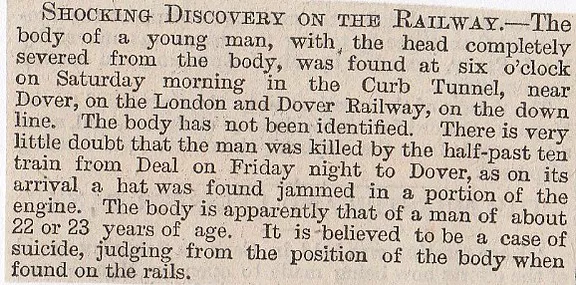
116/ Dungeness, January 1877
Early this morning the barque Congo sunk off No 2 Battery, Dungeness, during thick fog and in a rough sea. Unfortunately, nothing was known of the wreck at this lifeboat station of the National Institution until afterwards, when the lifeboat was launched and proceeded to the vessel, which was found deserted lying with her side almost under water. One of the crew of the lifeboat was washed overboard by the heavy seas, but was happily picked up again all right. It was afterwards ascertained that the crew of the barque, numbering nine men, had taken to their boat and had tried to make for the beach, but in doing so their boat capsized and, with the exception of one man who was washed ashore in an insensible state and who has since recovered, all the poor fellows perished.
117/ Garlings near Margate, (Corpse in Dung-Heap) January 1893
At Garlings near Margate, the corpse of a woman was discovered on a manure heap. The throat had been slashed and the head was barely attached to the neck and the razor used, was close by. The woman is described as five feet four inches tall, in her mid-forties and with the linen having the name “Chapman”. She wore a black dress with velvet around the base and a black fur lined cloth coat. Identification has not been possible, but someone of a similar description was seen in the area. (Murder/Suicide?)
118/ Ward near Sandwich, (Body in Ditch) August 1889

119/ Chatham, (Identical Suicide), May 1919
Walter Coulthrop, a painter, was found to have been suffocated in a gas oven, with two of his brothers killing themselves in an identical manner. They were both found with their head resting on the same cushion and in the same oven. One killed himself three weeks ago and Walter was warned at the inquest about the fatal fascination of the oven. “Suicide whilst temporarily insane”
120/ Offham Suicide, July 1879
This is one guy with mental health issues! William Irving was a fifty-year-old labourer, who liked a tipple. All very well you might say, but when he climbed a 70-foot tree in the presence of his wife and daughter and was singing hymns as he climbed, then stated when he got to the top: “Goodbye; I mean to do it with a good heart. I have made a nice noose, and I am now going to tie the knot. Marwood says that a drop of six feet is necessary, but I’m only going to give myself three feet. I have tied the knot, and I’m going to jump.” The people watching thought he was kidding, but as it turned out he wasn’t. This was fairly late in the evening and he had done it after his wife had berated him for staying out late at night.
121/ Malling Vicar Suicide, August 1889

122/ Faversham, September 1909 (Decomposed Body)
A man’s body was discovered in a line of larch trees at Faversham in Kent. The corpse was in a dreadful state of decomposition and not a million miles away from the railway, but estimates reckon it had been there for weeks not days.
123/ Dover, September 1892 (Strange Suicide Letter)
Margaret Dawtry Doig, a twenty-two-year-old Londoner, was found smashed to bits on the rocks near Dover. Margaret had leapt off a three hundred foot cliff and it had lodged between some rocks, otherwise, it would have been swept out by the tide into the English Channel. She sent a letter to her boyfriend’s brother explaining matters. It read as follows:-
“Your letter destroyed the last hope I had, as no doubt it was intended to. You are very kind when you offer to help me-so kind indeed, that you make me wonder whether you persuaded your brother to give me up. If so, you have been the means of wrecking my life. I am a good and intelligent woman, quite as well born as yourselves, and your brother would have been a happier man had he been my lover. The worst part of this cruelty was that he thoroughly knew my worth. He professed to think himself very fortunate- as indeed he was- to have won me. He would have been ennobled mentally and morally by the alliance. No one knows better than himself. I was never able to care for any man until I met him, I had dreams, of course, but they were purely ideal. I am alone in the world, without a single creature to care for me. Your brother gave me a new interest in life. I should have existed solely for him. I do not want you to imagine that I took my life in a frantic moment. I have been considering for several days whether I could bear to live on, and find I have no strength. I am going to Dover to walk over the cliff. My death may, perhaps, be considered accidental. So much the better. I wish your brother to know how I died. I have every right to be remembered by him, and he is still very dear to me. Will you do my memory the justice to tell him the truth. If I wrong you by my suspicions, I am sorry.” MARGARET DAWTRY DOIG
124/ Folkestone Boat Accident, May 1899
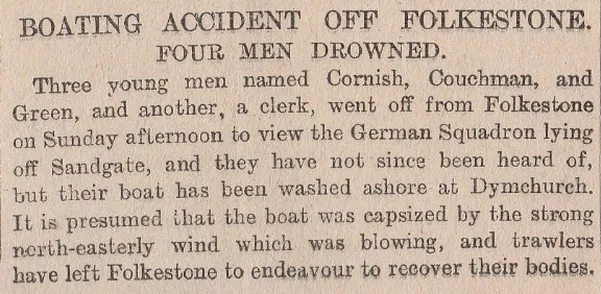
125/ Sevenoaks Shooting, May 2nd, 1885
A farmer named Douglas, residing at Sevenoaks, became involved in a dispute yesterday with a corn dealer named White and shot him through the chest with a revolver. Douglas then fired at, but missed, a police superintendent who stood nearby. He has not yet been captured.
Sevenoaks May 5th, 1885
John Ambrose Douglas, farmer, who shot Mr White, corn dealer at Sevenoaks last Friday and afterwards escaped, surrendered to the police in London yesterday afternoon. Little hope is entertained of Mr White’s recovery.
126/ Margate Lifeboat Inquest, December 1897
An inquest on the bodies of nine men drowned by Margate Lifeboat Disaster asked one of the survivors, Robert Ladd, who said he had been on hundreds of operations over the past decade and not once had the boat turned over before. They had no lifebelts and they wouldn’t use them anyway as they were a hindrance. The boat flipped over in twelve feet of water and about a quarter of a mile from the shore. Verdict “Accidental Death”.
127/ Brompton Pub Murder/Suicide, near Chatham, March 1900
William Bailey, a thirty-six-year-old dockyard labourer tried to kill a woman named Thorne in a public-house, then slit his own throat. He had lived in Brompton for fourteen years and had split up from his missus no less than seven times. They split up again, but this time Bailey became jealous and began stalking her and watching the house where she lived. He was in a pub nearby, when he saw a jug of hers, so he went to the next compartment, met a woman coming out with a jug of beer and thinking it was his wife, cut her throat. He then slit his throat and ran out of the pub and fell down dead in the street. (Did woman survive?/ What pub?)
128/ Gravesend Murder, February 1881
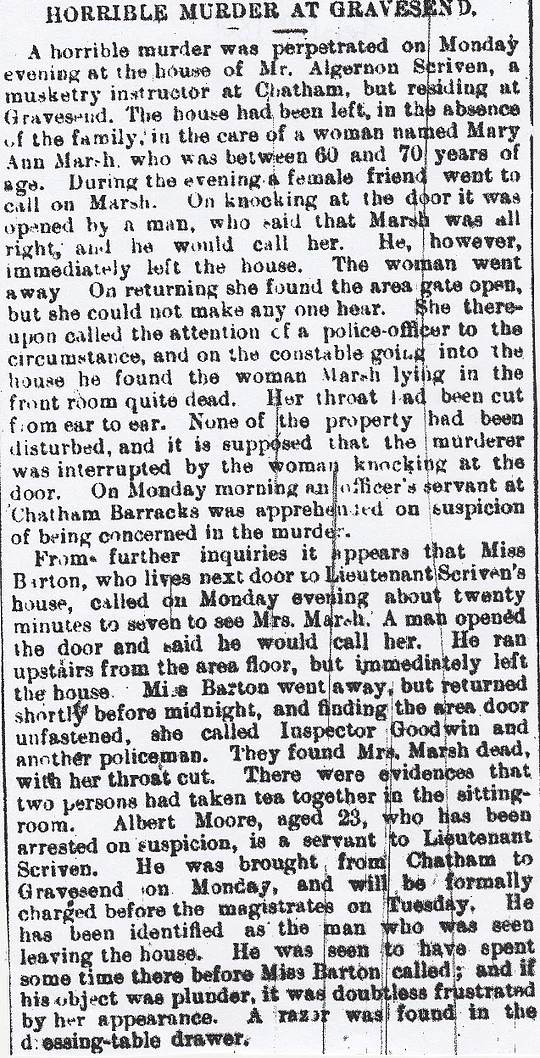
129/ Chatham Soldier Suicide, December 1852
Private William Clark of the 95th Regiment, killed himself by shooting himself in the head while on sentry duty from the lower dock guard. He put his musket in his mouth and fired, blowing away the top of his head. He was an exemplary soldier with twelve years service and just returned from service in India a few months ago. There is no reason why the thirty-three-year-old Brummie would have done this, except he was prone to giddiness in the head.
130/ Ramsgate, (Body Washed Ashore) August 1910
A man named Gore was walking along the beach at Pegwell Bay when he saw something floating on the surface of the sea. He went and got it out thinking it was flotsam or driftwood, but it turned out to be the body of a female. He acquired help and they took it to Ramsgate Harbour. No sign of identification, but she clutched eleven pence in her right hand!
131/ Margate, September 1896 (Man Decapitated)
The headless body of Charles Bartholemew Pyle, a twenty-six-year-old male, who lived at Marine Terrace in Margate. He was found on the South Eastern Line near to the town, minus the head, which was thirty yards from the body, and was also missing his right foot as well. He was due to be in court for threatening his wife the following day and in a strange twist of fate, his brother killed himself a couple of years ago in a similar fashion.
132/ Sittingbourne, (Cruel Schoolmaster) May 1885
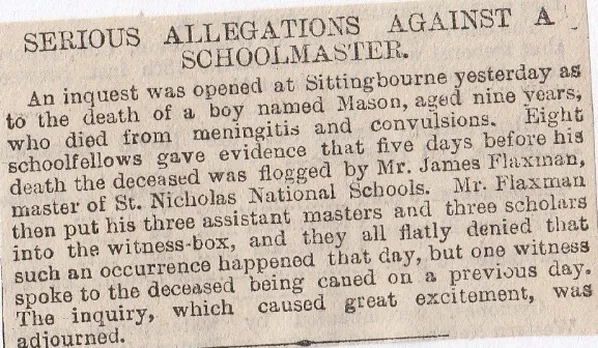
133/ Tunbridge Wells, (Concealment of Birth) August 1876
A sensation was created in Tunbridge Wells when a body of a dead child was discovered at the home of the late General Molyneux Williams. It seems that some bits and bobs from around the house had vanished and Mrs Williams accused a domestic servant, Elizabeth Williams of pinching them. Police came to search the premises and when they asked Elizabeth if they could look in her room, she refused. When a box was finally opened in her room, the reason for her not letting them in became apparent, when they were confronted with the remains of an infant. It was wrapped in sheets and several items that had gone missing were also there. Lime had been used to destroy the carcass and Williams was arrested for concealment of birth. When questioned she told police that it had been born a year and a half ago and it had been there ever since.
134/ Faversham, January 1894 (Eaten by Cat)
Sixty-five-year-old former grocer, George Clarke, was found dead in his house in Court Street in Faversham. The alarm was raised when a relative hadn’t seen him for a week and a half, so went to call on him and found him on the floor. The cat who lived with him was obviously hungry and being locked in for so long, it ate his face. “Death through natural causes” was the verdict and he had suffered from an epileptic seizure.
135/ Canterbury, August 1856 (Romantic Suicide/Sad Letter)
Elizabeth Ann Steer aged twenty-one, committed suicide by hanging herself in her brother’s wash-house. This is a sad tale and romantic in some ways, but she was supposed to have been married the previous day to a carabineer(soldier who uses a carbine, like a sawn-off rifle!) named Greaves, but he was refused leave and her friends opposed it, particularly her mother-in-law, who had caused her to leave home. Steer had gone out with a man called George West before Greaves and had sent him her last letter, meanwhile, the carabineers and the love of her life were on their way to India. The note read:
“George- You took great trouble to write to me on Tuesday about my going out with Greaves. He was a man- he will either live or die for me, and I will do so for him. Remember George, how you deceived me. Daily and hourly you sought my ruin- often did you wish me to get me into trouble, but the Lord protected me so far. Your conscience will tell you, you was a base, deceitful man, but God never pays debts with money. My life I will forfeit. Pay my dear Father and Mother what you owe me- it will pay for my funeral. You have broken my mind- you seduced me- and God will reward you for it. You will never prosper. Remember these last dying words of one who has been the dupe of all your lies. My heart aches- my hand trembles- and in a few moments I shall be launched into eternity”.
It brings a tear to the eye doesn’t it? Anyway, she was said to be”under temporary insanity” by the jury. Sounds more like a woman who deeply cares for a man, to me.
136/ Atchcliffe Fort Fatality, Dover, August 1860 (Sorry bottom bit missing!)

137/ Maidstone, November 1897 (Suicide While Strolling)
A young chap named Lower was out with his sweetheart for a pleasant stroll along a pathway near the railway bridge across the River Medway. He suddenly gave her his watch and chain and hurdled himself over the wall. It was the intention to drown himself, but he fell the fifty feet onto the wharf beneath. The couple were in love with each other, so again the question is, Why?
138/ Ramsgate, April 1859
Heinrich Matterig, alias Maltinger, landed at Southampton on March 31st, on a vessel from America. In a bid to commit suicide and not leave any clues to his identity, he was on an omnibus on the Dover and Deal Road when he threw a 1756 Bible off the top. It had a piece of paper in it, with five German letters and the year 1827 written on it. His clothing is slightly scruffy so his account of a travelling gentleman on his way to Paris, then on to Scotland is not correct.
139/ Chatham, February 1842 (Medway Union Workhouse Suicide)
Joseph Anderson was an inmate of the Medway Union Workhouse at Chatham, who killed himself by nearly severing his head from his body. He was in a sick ward recovering, but it was twelve feet square and had twelve patients. At midnight one of the other patients heard a noise and when the light was lit, it was found he’d cut his throat, but nearly cutting it from his neck, so deep was the gash. He was seventy-five-years-old and had a wife who lived in Brompton.
140/ Walmer Cliff Fatality, August 1890

141/ Rosherville near Gravesend, May 1889
Sixteen-year-old Edwin Saunders killed himself by jumping off a cliff. He was adopted as an infant and worked for Woollett, a grocer in Gravesend. A note found in his pocket read:-
“36 New Road, Gravesend, May 12th.
Mrs Woollett, I am tired of life. I asked A.Nettlingham if she would have me for a lover, and she said “No!”. She was the only girl I ever loved, and so I swore I would end my life. Alice Nettlingham is the only one to blame, and may the curse of my head ever be upon her. I am very sorry to leave you in such a way after being so kind to me all my life- I remain EDDIE”
The young lass, Alice Nettlingham, was overcome in court, with the verdict being “Suicide whilst temporarily insane.”
142/ Dover Horrific Train Death, October 1885
A young man named Prue was run over by the Deal train, on the London, Chatham & Dover Railway, near Dover. The manner of his death is horrific. Prue worked at the Dover Officer’s Club and had been to the Priory Station to see his father who he thought was on duty as a signalman. He wasn’t, so he went through the tunnel when he was struck by a train. This bit is really gory! Half his head, with the body, was on one side of the track and the other- the complete face, with a part of his ear, was on the other side a few yards away. There was his hat and some blood and hair too.”Accidental Death”
143/ Chatham (School of Military Engineering), August 1885

144/ Hever, (Murder or Suicide?)October 1886
Lottie Spittles, a 23-year-old domestic servant residing at Thornton Heath near Croydon, was found drowned in a pond. Lottie had been to Hever to see some friends, with her mistress with her as well. They were walking back to Edenbridge Railway Station when Lottie was seen talking to a male cousin of hers outside the station, then the train went without her. The cousin, John Heaysman, who was later questioned, said that she wasn’t going to return by a later train but stay with her aunt in Hever and go back tomorrow morning. She also said she didn’t care if she never went back and would rather kill herself. Heaysman was with a mate called Worzell and they all went for a few pints, then back home, but when they got to Bower Farm in Hever, Heaysman left them for a while and when he came back, they’d gone. Next time he saw his cousin was as a dead body. Worzell is a man to be questioned. Deceased also had an ear-ring torn out of her ear. (Was it Worzell?)
145/ Chislehurst Cab Suicide, March 1862
John Gravatt aged nineteen, committed suicide while taking a ride in a cab. He had left home to go and look for work, but on Saturday morning at three o’clock, he was in the Crown and Anchor on the Old Kent Road. He asked a cab-man, Benjamin Gallin, to take him to Chislehurst and when they came up to Chislehurst Common, the cab-man heard a gunshot. Gallin looked into the cab and saw the passenger with a pistol in his hand and blood seeping from a head wound. On his person was a letter to his Dad, saying that he intended to kill himself and giving the excuse that family grievances were to blame.
146/ Tonbridge, December 1905 (Oxford Student Suicide)
The body of a young man was found on the railway in a tunnel close to the station, in a dreadfully mangled condition. There was a card with the name Guy L.Gibbins on it. What alerted staff on the train he was travelling on, was an open door to a carriage, just as they were coming into Tonbridge from Tunbridge Wells. An employee went down the line to look for a body and he found him in a tunnel between Southborough and Tonbridge. The body was taken to Tonbridge. The card found on him gave the address,”Guy Gibbins- 62 London Road, Tunbridge Wells”. The explanation for his rash act was that he had failed an important exam and became depressed. Twenty-year-old Guy was a student at Keeble College.
147/ Folkestone, May 1878 (Actual loss was 270 lives and many are buried in Cheriton Road Cemetery, where there is a memorial)
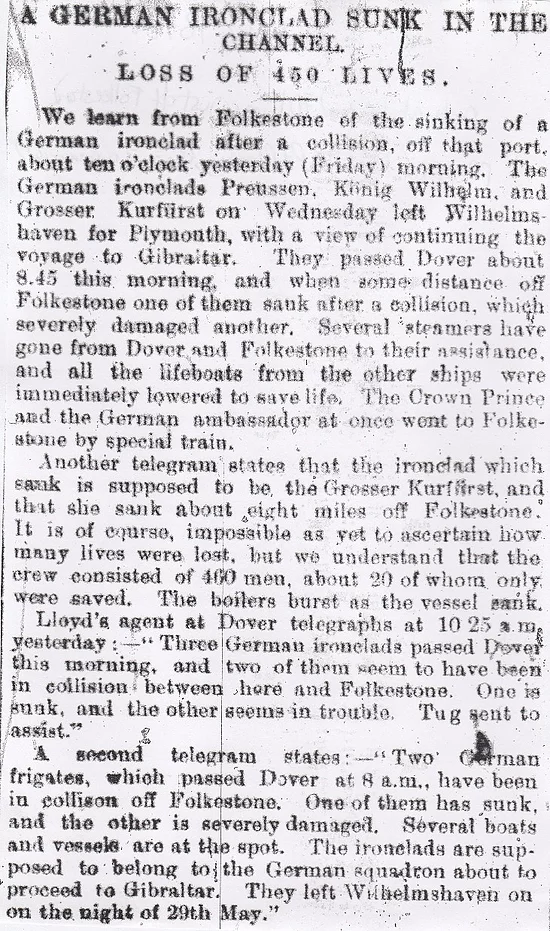
148/ Minster-on-Sea Murder, November 1906
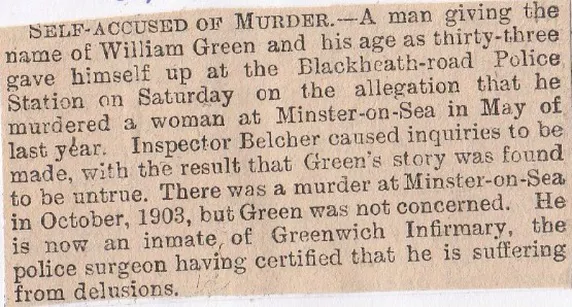
149/ Rochester Suicide, March 1898

150/ Northfleet near Gravesend, November 1882 (Death by Hot Water)
Fifty-three-year-old labourer, Thomas Briggs from Northfleet, was sat down to breakfast one morning, when he leaped up and shouted “Here goes”, then walking to the fireplace and took a kettle of boiling water, popped the spout in his mouth and then began to drink the contents. His wife managed to wrangle the kettle away from him but he had nearly finished the entire amount of liquid in the kettle and when asked what he was doing, he simply replied: “I don’t know, I thought I was having a cup of tea”.
The larynx swelled up and he died from suffocation within the hour.”Suicide whilst of unsound mind” was the verdict.
151/ Rochester Poker Suicide, December 1885
Thomas Raycraft decided to end it all one day, but didn’t walk in front of a train, hang himself, poison or even shoot himself. Raycraft thought that ramming a red-hot poker down his throat, then forcing it through the roof of his mouth was a good idea. He lingered for a day and a half in enormous pain, before passing away.
152/ Medway/Rochester Double Suicide, August 1843
A double suicide of a young couple named William Hendery and Ann Sancti, had rocked the town of Rochester in 1843. They went on a pub crawl on the fateful day, drunk ale, cider and gin, then gone to the Medway and jumped in together. The total number of deaths was three, because she was pregnant as well.
153/ Kent County Lunatic Asylum Murder, Barming Heath, August 9th, 1851
The inquest was held at the Kent County Lunatic Asylum, Barming Heath, on the body of a patient there. John Hubble aged seventy-six years of age, who was savagely beaten by another patient, Henry Hills on the 9th of August. Hubble was bruised and beaten and several jury members seemed to be surprised that Hubble had lived so long after the attack had taken place. He was beaten with some kind of weapon or household utensil.
154/ Sheerness, October 1822 (Bellerophon)
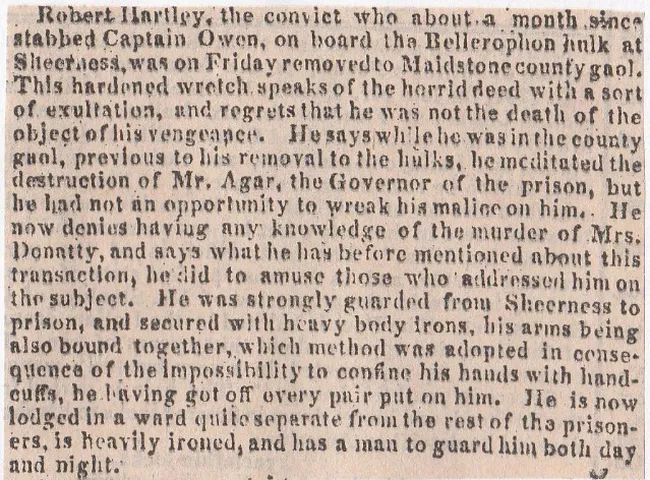
155/ Queenborough Fire, February 1895
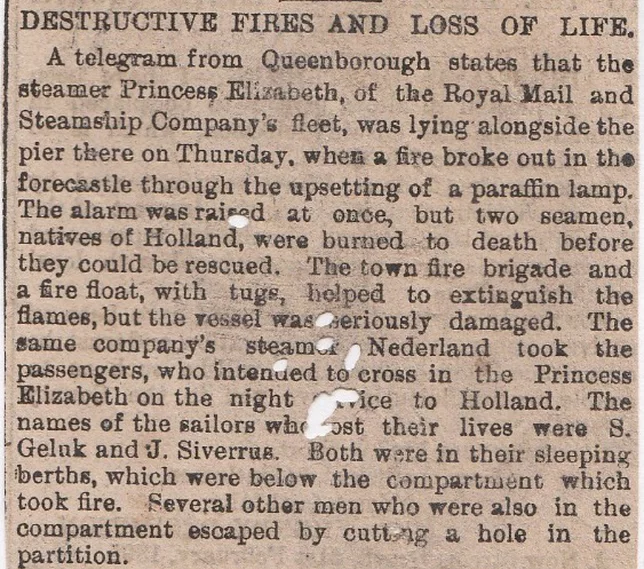
156/ Dover Coast, (Suicide from Steamer) November 1903
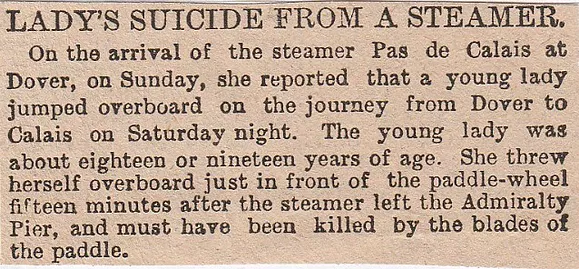
157/ Body Found near Erith, September 1870
The body of the lad Ernest Keating, the protege of the late Reverend C.Hind, one of those lost in the collision between the Cormorant and the pinnace of the training ship Chichester on the 8th inst, was found in the river off Erith on Friday night. A reward of a £1 had been offered for its recovery. The bodies of the six persons drowned have now been recovered. Keating’s remains were conveyed to Woolwich on Saturday, where the adjourned inquest is to be held.
158/ Margate Drownings, September 1870
On Wednesday afternoon two men were drowned at Marsh Bay near Margate. It appears that a boatman named Davis was engaged by three male visitors to take them out in his rowing boat, the Emily, and that when off Marsh Bay the boat capsized and the boatman and one of the gentlemen were drowned. The two gentlemen who survived were rescued by the pleasure yacht “Secret”, and were conveyed to the Hoy Hotel, where they were promptly attended to. The boat has also been recovered, but at the time this was written the two bodies had not been found.
159/ Wouldham Camp Drowning, August 1870.
160/ Cannon Bridge Drownings, Tonbridge September 1870 (Cannon Lane, Tonbridge. The bridge that goes over it; is this Cannon Bridge? The Mitre was at 24 Hadlow Road, it was demolished and Mitre Court was built sometime in the 1980’s)
161/ Fort Green Suicide, Margate 14th September 1870.
Shortly before eight o’clock yesterday morning a visitor, named Charlotte Eliza Wickison, a married woman aged thirty, of 6, Farm Place, Walham Green, Fulham, committed suicide by throwing herself from the Fort Green, Margate, onto the sands below, a distance of about sixty feet. She received some very extensive scalp wound and a fracture of the skull; her right leg was broken and she had other injuries. Death was instantaneous.
September 21st 1870- Inquest.
162/ Deal (Three Boatmen Drowned) August 1870.
163/ Erith Fatal Yacht Accident, August 1870 (I know it’s in Bexley, but was in Kent at the time)
164/ Ulcomb Accidental Shooting, November 1870.
165/ Thurnham Murder, October 1870 (Black Horse Inn is still there.)
166/ Tonbridge Child Murder, January 18th, 1902 (Harold Apted killed Frances O’Rourke)
March 1st, 1902 (Tonbridge Murder Verdict)
At Maidstone Assizes on Wednesday, Harold Apted was found guilty of the wilful murder of the child O’Rourke, at Tonbridge, and sentenced to death, with a recommendation to mercy on account of his youth. In passing sentence Mr Justice Wright said no one could doubt that the jury had come to the right decision.

